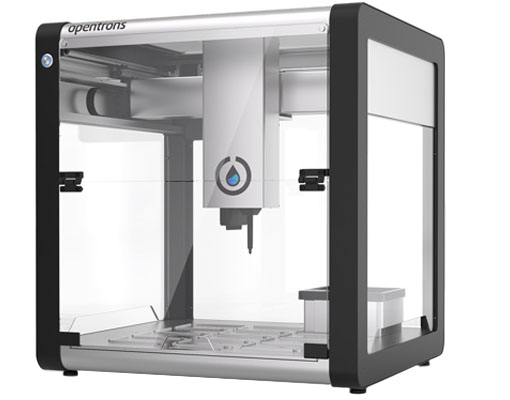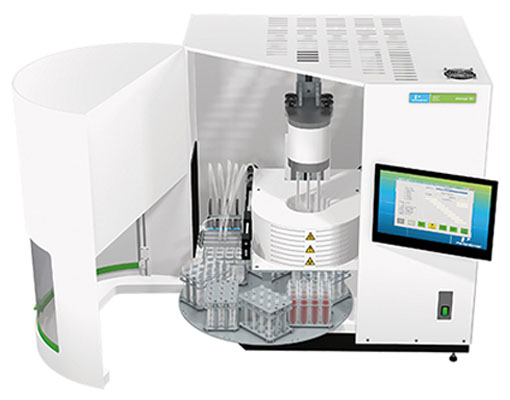Multiplex PCR Testing Equipment
MAS has adopted the leading edge technology of multiplexing with the addition of the Opentrons OT-2 robots, QuantStudio 12K Flex Real-Time PCR and the Chemagic 360.

OT-2 by Opentrons

QuantStudio 12K Flex Real-Time PCR

Chemagic 360
4 target technology for faster and more accurate results:
- RdRp (RNA-dependent RNA polymerase)
- N (nucleoprotein)
- E (envelope protein gene)
- RNaseP
Combining robotics and multiplexing provides the most advanced testing solutions in the healthcare marketplace. These enhanced testing capabilities enable MAS to accurately and quickly deliver critical results. Together, with this latest technology and our team of highly trained laboratory scientists, technologists, pathologists, and chemists, we bring you leadership in laboratory testing services.
Why we invested in Openstrons cutting edge robotics:
- Improves accuracy
- Uses 4 target multiplexing technology
- Eliminates false positives
- Enhances testing capacity
- Provides results within 24 hours
How does it work?
Robotics can automate hundreds of life science protocols and workflows while offering speed and efficiency that can only be attained with this system. The risks of human error with manual sample handling can be circumvented by automating nucleic acid extraction with robotics, thus ensuring greater consistency and reliability as well as better quality data overall.
Additional benefits of automated protocols:
- Streamlined extraction process: Accurate and consistent pipetting is possible with an automated protocol.
- Less manipulation, less contamination: Fewer manual handling and pipetting steps reduce the threat of external contamination and sample-carryover risk.
- Throughput and scope: With automated nucleic acid extraction you can process larger sample numbers with greater speed, thus increasing overall throughput.
- Time-saving: Automation allows for the robot takes care of the repetitive work. Automated protocols are faster.
Using Robotics and PCR Testing capabilities for COVID-19:
Real-time PCR (Polymerase Chain Reaction) is a valuable molecular technique performed in a high complexity laboratory to accurately analyze the genetic material of pathogens. As a modern molecular biology lab, MAS utilizes PCR to identify and quantify both bacteria and viruses as well as to determine antibiotic resistance. PCR is 3-5X more sensitive than conventional culture techniques and allows us to report results for both pathogen identification and antibiotic resistance.
More about PCR Testing:
- PCR tests help to identify the presence of the COVID-19 (Sars -CoV-2) virus
- OT-2 by Opentrons, QuantStudio 12K Flex Real-Time PCR Chemagic 360
- Test is conducted with a nasal-pharyngeal swab sample (NP, upper respiratory).
- Results are ready within 24 of receiving the specimen to identify if the virus is present.
- Each test is covered by all insurance plans and un-insured at 100% of the allowed amount without any patient responsibility (no copay or deductibles apply).
Clinical Advantages
- Detects Polymicrobial Infections at Once
- Provides an Accurate Diagnosis within 24 hours
- Unaffected by Concurrent Antibiotic Use
- Decreases Additional Unnecessary Diagnostic Testing
- Lowers Healthcare Costs
- Identifies Antibiotic Resistance
- Improves Antibiotic Stewardship
- Reduction Unnecessary Drug Exposure and Adverse Events
- Decrease Patient Risks
- Eliminates Subjectivity
- Improves Patient Satisfaction
What is COVID-19?
In 2019, a new coronavirus was identified as the severe acute respiratory syndrome coronavirus 2 (SARS-CoV-2). The disease that it causes is referred to as COVID-19.
What’s the criteria for testing?
COVID-19 symptoms include:
- Body temperature greater 100 degrees
- Persistent headache or dry cough
- Sudden loss of taste or smell
- Chest pain that does not subside
- Severe muscle aches
- Shortness of breath or labored breathing
- Nausea
- Vomiting
- Diarrhea
Am I a candidate for COViD-19 testing?
Exposure to someone with COVID-19 or someone waiting for results of testing could also make you or your staff a candidate for testing. If you’ve been exposed to someone with COVID-19, it could take up to 14 days to see symptoms, but the average is five days.
People ages 60 and older, undergoing cancer treatment, taking biologics or immune suppressant medications, or have lung disease, heart disease, end stage kidney disease, advanced HIV or an organ transplant can receive preferential screening to their increased risk.
Other symptoms can include:
- Fatigue
- Body Aches
- Runny nose
- Sore throat
Other risk factors that you may be a candidate for testing:
- Possible exposure through recent travel to an affected country or state or if you reside in a heavily affected community.
- Close contact with someone who has tested positive for COVID-19.
- Older adults and those who have severe underlying chronic medical conditions such as heart or lung disease or diabetes could be at a higher risk for developing more serious complications from the COVID-19 virus. (Source CDC.gov)
